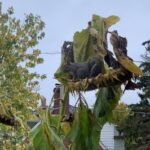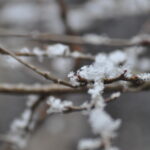By Rich Niccum, Education Services Manager

Garden beds that is. Each year at this time, there is a mad rush to clean up garden beds in urban, suburban, and rural neighborhoods all over the eastern half of North America and beyond. There is the urge for everything to look nice and kept, not allowing “unsightly” dead plants to clutter our gardens. I will admit, I have been guilty of this in the past but realized the error of my ways years ago, and encourage you to rethink your fall garden cleanup ritual as well.
“Why should I leave all the dead and dying plants in place through the winter you ask? “Let me count the ways,” as someone famous once said.
- Dead or dormant plants left in your gardens during the winter months provide protected spaces for wildlife of all shapes and sizes to ride out the winter. For example, North America has over 3,500 species of native bees that need refuge from the cold and predators. They find respite by hiding in hollow plant stems, amidst native grasses, or the peeling bark of a redbud tree.
- Your winter garden will also provide shelter for butterflies in different stages of life. Butterflies, like all other insects are cold-blooded. In the winter months, they hibernate, their bodies getting rid of excess water and many generating glycols that act as a natural antifreeze to protect them. You may find a black swallowtail or cabbage white chrysalis on a branch, an adult question mark or mourning cloak butterfly in the leaf litter, or even a viceroy or meadow fritillary caterpillar seeking refuge in a seedpod avoiding hungry predators.
- Cleaning out your garden removes a protective layer of leaves and other detritus for the soil below. Depending on your situation, this can offer a refuge for hibernating toads, tree frogs and other amphibians that dig down into the soil below your plants. Gray tree frogs for example hibernate in leaf litter or under bark of trees. As temperatures drop, up to 40 percent of the water in their bodies freeze, they stop breathing and their heart stops. Once warmer weather comes in the spring they thaw out and amazingly hop away.
- We certainly can’t forget about the birds that brighten the cold winter days. A robust winter garden provides interest for a variety of birds. They are attracted by the various seeds, berries, hibernating insects and even shelter. You will see an increase in the diversity and number of birds coming to your garden as a result. Chickadees, nuthatches, robins, cardinals, bluebirds and others will flock to your yard for the free buffet and lodging offered up throughout the winter.
- Last but not least, let’s talk about how we humans benefit from the winter garden. I can’t imagine looking out into a yard devoid of plants. At least with a winter garden there is something interesting and beautiful to see on a frigid winter day. Imagine the beauty of a morning frost covering every leaf, seed pod and stem in your garden; new fallen snow resting on branches or bright red berries adding color to an otherwise drab background. You can also add a smile or chuckle to your daily life like I am as I write this, watching the gray squirrels working to get the seeds from the mammoth sunflowers in my yard.

These are just some of the benefits “untending” a winter garden provides. We emphasize the importance of planting natives in your gardens in the warm seasons for the benefits they provide wildlife, but we should not forget that dead or dormant plants provide great benefits in the cold months as well. So, I am laying down the gauntlet, “Don’t cleanout/cleanup and tidy your garden this fall!”, or if you must do only a minimal amount. The good that you will be doing wildlife, your plants, and yourself will pay dividends throughout the winter and beyond.






